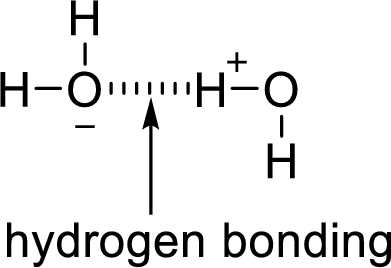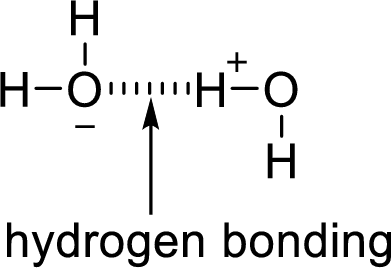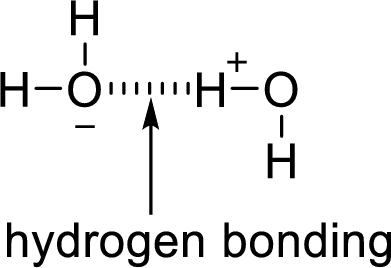
Concept explainers
(a)
Interpretation:
From the given compounds, compounds with higher value of solubility has to be identified and the reason for the higher value of solubility has to be explained.
The given compounds are chloroethane and methylethylamine.
Concept Introduction:
The physical properties are determined by the intermolecular forces, polarity of the compound and hydrogen bonding. If a compound is polar and have hydrogen bonding, the solubility will be more for that compound than in non-polar compounds.
Intermolecular forces:
The forces which acts in between the atoms to hold a molecule are said to be intermolecular forces. They are weak forces. Intermolecular forces are categorized as hydrogen bonding, ionic bonding, ion-induced dipole forces, ion-dipole forces and Vanderwaal forces.
Hydrogen bonding:
The attraction between a lone pair of hydrogen atom with that of an electronegative atom forms hydrogen bonding. Two water molecules are held together by hydrogen bond.

(b)
Interpretation:
From the given compounds, compounds with higher value of melting point has to be identified and the reason for the higher value of melting point has to be explained.
The given compounds are diethyl ether and 1-butanol.
Concept Introduction:
The physical properties are determined by the intermolecular forces, polarity of the compound and hydrogen bonding. If a compound is polar and have hydrogen bonding, the melting point will be more for that compound than in non-polar compounds.
Intermolecular forces:
The forces which acts in between the atoms to hold a molecule are said to be intermolecular forces. They are weak forces. Intermolecular forces are categorized as hydrogen bonding, ionic bonding, ion-induced dipole forces, ion-dipole forces and Vanderwaal forces.
Hydrogen bonding:
The attraction between a lone pair of hydrogen atom with that of an electronegative atom forms hydrogen bonding. Two water molecules are held together by hydrogen bond.

(c)
Interpretation:
From the given compounds, compounds with higher value of boiling point has to be identified and the reason for the higher value of boiling point has to be explained.
The given compounds are trimethylamine and propylamine.
Concept Introduction:
The physical properties are determined by the intermolecular forces, polarity of the compound and hydrogen bonding. If a compound is polar and have hydrogen bonding, the boiling point will be more for that compound than in non-polar compounds.
Intermolecular forces:
The forces which acts in between the atoms to hold a molecule are said to be intermolecular forces. They are weak forces. Intermolecular forces are categorized as hydrogen bonding, ionic bonding, ion-induced dipole forces, ion-dipole forces and Vanderwaal forces.
Hydrogen bonding:
The attraction between a lone pair of hydrogen atom with that of an electronegative atom forms hydrogen bonding. Two water molecules are held together by hydrogen bond.

Want to see the full answer?
Check out a sample textbook solution
Chapter 15 Solutions
Chemistry: The Molecular Nature of Matter and Change
 ChemistryChemistryISBN:9781305957404Author:Steven S. Zumdahl, Susan A. Zumdahl, Donald J. DeCostePublisher:Cengage Learning
ChemistryChemistryISBN:9781305957404Author:Steven S. Zumdahl, Susan A. Zumdahl, Donald J. DeCostePublisher:Cengage Learning ChemistryChemistryISBN:9781259911156Author:Raymond Chang Dr., Jason Overby ProfessorPublisher:McGraw-Hill Education
ChemistryChemistryISBN:9781259911156Author:Raymond Chang Dr., Jason Overby ProfessorPublisher:McGraw-Hill Education Principles of Instrumental AnalysisChemistryISBN:9781305577213Author:Douglas A. Skoog, F. James Holler, Stanley R. CrouchPublisher:Cengage Learning
Principles of Instrumental AnalysisChemistryISBN:9781305577213Author:Douglas A. Skoog, F. James Holler, Stanley R. CrouchPublisher:Cengage Learning Organic ChemistryChemistryISBN:9780078021558Author:Janice Gorzynski Smith Dr.Publisher:McGraw-Hill Education
Organic ChemistryChemistryISBN:9780078021558Author:Janice Gorzynski Smith Dr.Publisher:McGraw-Hill Education Chemistry: Principles and ReactionsChemistryISBN:9781305079373Author:William L. Masterton, Cecile N. HurleyPublisher:Cengage Learning
Chemistry: Principles and ReactionsChemistryISBN:9781305079373Author:William L. Masterton, Cecile N. HurleyPublisher:Cengage Learning Elementary Principles of Chemical Processes, Bind...ChemistryISBN:9781118431221Author:Richard M. Felder, Ronald W. Rousseau, Lisa G. BullardPublisher:WILEY
Elementary Principles of Chemical Processes, Bind...ChemistryISBN:9781118431221Author:Richard M. Felder, Ronald W. Rousseau, Lisa G. BullardPublisher:WILEY





